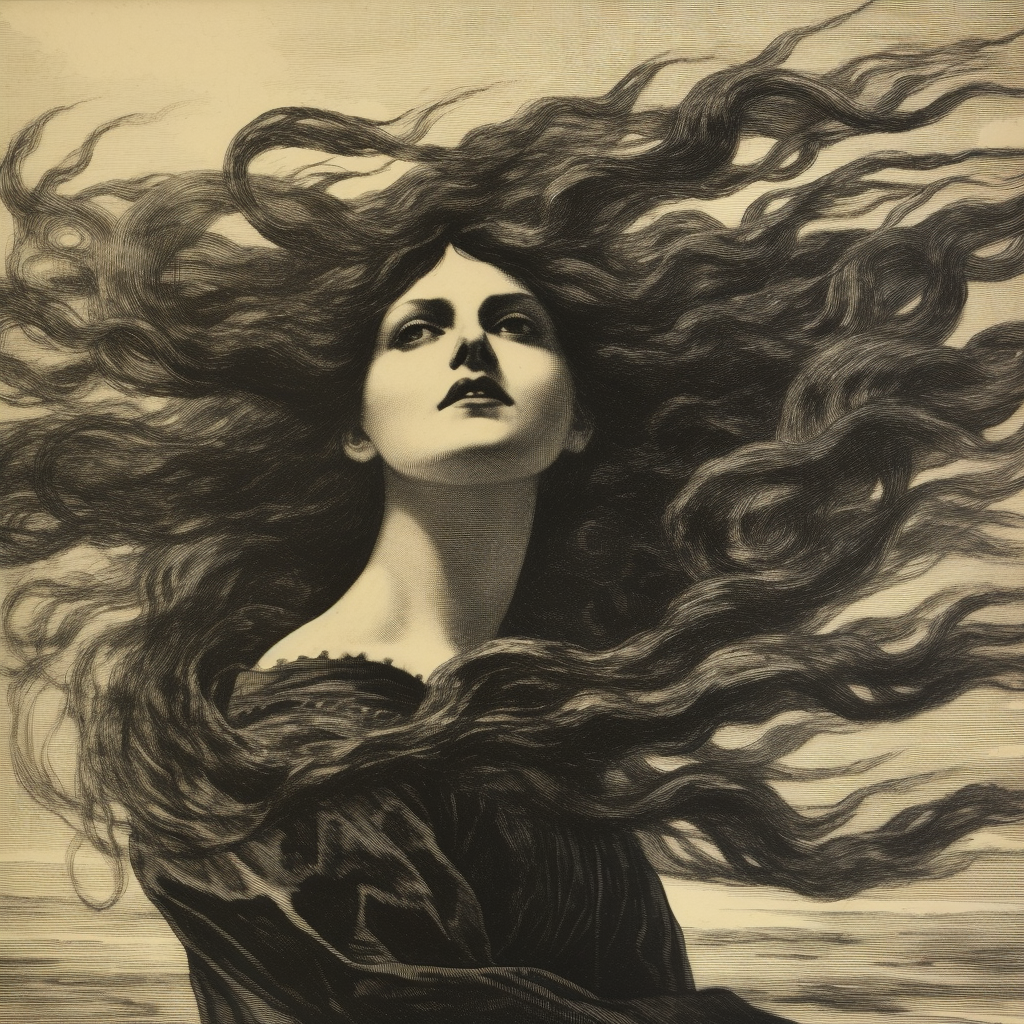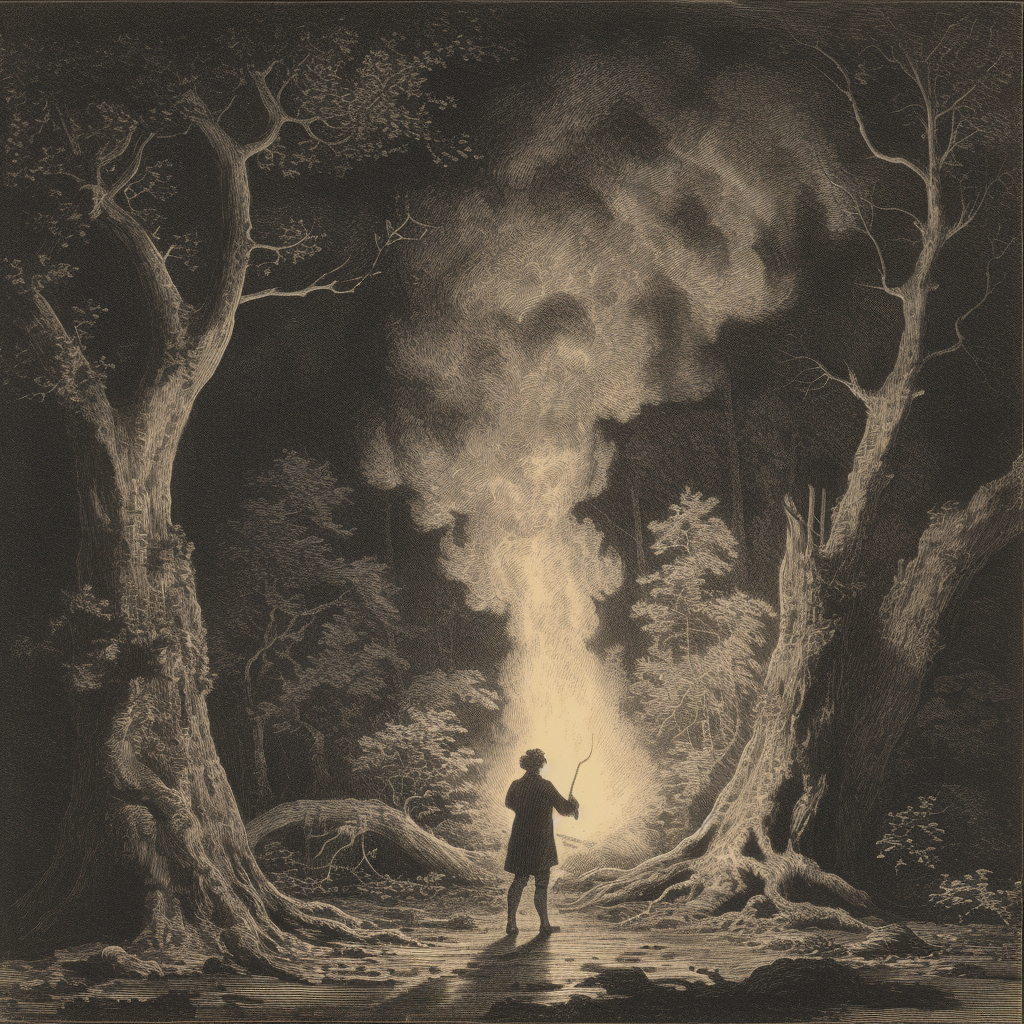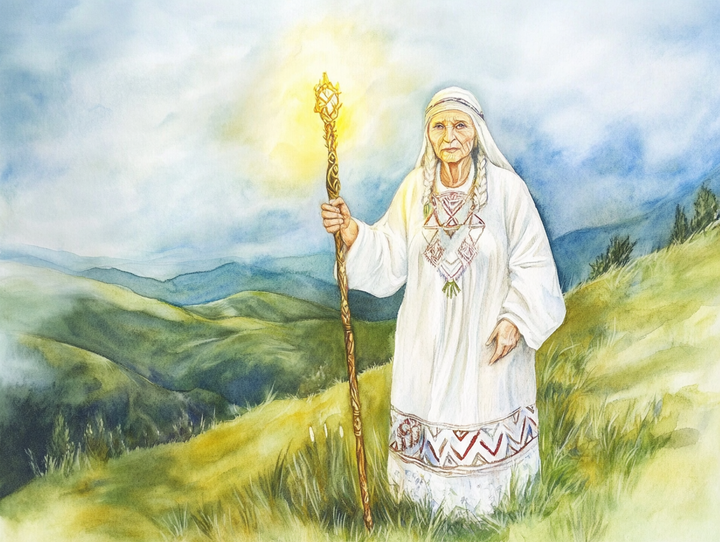Balkan Myths: A Journey through the Stories of Ivanić-Grad

In the heart of Croatia, nestled between the bustling city of Zagreb and the tranquil banks of the Sava River, lies the charming town of Ivanić-Grad. This town, steeped in history and folklore, was the canvas upon which Đuro Deželić, a renowned Croatian folklorist, painted his vivid tales. In the year 1863, Deželić meticulously documented the local lore, capturing the essence of the region's rich cultural tapestry. Today, we delve into these captivating narratives.
The Dance of the Vila
Through the ages, whispers of the Vila, beings of ethereal beauty, resonated in the dark forest. Their faces, radiant as the morning sun, were framed by cascades of hair, black as a raven's wing or golden as the harvest grain, that flowed down to the earth. Their forms were akin to those of mortal women, save for their legs, which bore the semblance of a goat's, shrouded in a veil of white.
The Vila were known for their silken threads, delicate as a spider's web and white as the first snowfall. These threads, often seen floating in the air after a rain shower, were called "Vila's silk." Some even claimed that these threads were the Vila themselves. The Vila were creatures of the night, their voices harmonizing in songs more beautiful than any earthly melody. Only a select few were granted the privilege to witness their dance and hear their song - mostly shepherds, who led lives as serene as the pastures they tended.
The Phantom Fire of Knež Forest
One such tale speaks of a stableman from Cepetić, who, while wandering through the Knež forest, was lured by the sound of laughter and the rhythm of an unseen dance. The forest, usually a familiar place, seemed to transform into a labyrinth of shadows and whispers. His heart pounded in his chest as he followed the sound, curiosity and fear warring within him.
He found himself under a towering oak tree, where a fire blazed fiercely, yet, there was no one around, only the faint imprint of a dance on the grass. The stableman, entranced by the fire's ethereal glow, used it to light his pipe. But as he inhaled the smoke, he felt no heat, only a chilling dread that crawled up his spine. The laughter and music faded, replaced by an eerie silence that seemed to swallow the forest.

Overcome by fear, he fled from the forest to his fellow stablemen. His pipe continued to emit smoke, and when he finally dared to empty it, he found a single coin inside. The stableman's life was cut short soon after this encounter. His once jovial nature was replaced by a haunted look, and he spoke little, often lost in his own thoughts.
The villagers whispered that had he not fled, he might have lived. But such is the price for crossing paths with the Vila - a fleeting glimpse of the extraordinary, followed by an eternity of silence. The tale of the stableman served as a chilling reminder of the unseen world that existed alongside their own, a world that was as fascinating as it was terrifying.
The Enchanting Visitor of Knež
In the heart of Knež forest, a land whispered about in hushed tones, there lived a horseman, a solitary figure who found solace in the company of his equine companions. One evening, as the embers of his fire danced and crackled, roasting ears of corn, a vision of beauty materialized before him. A woman, ethereal in her whiteness, held the mane of his most majestic horse, her eyes brimming with a sorrow that echoed in the silent night.

The horseman, entranced by her beauty yet puzzled by her sadness, dared to ask what burdened her heart. Her lips, pale as moonlight, parted to request the ownership of his prized horse. The horseman, ignorant of the spectral nature of the woman, declined, his voice trembling with uncertainty. Yet, with an air of inevitability, she mounted the horse, her spectral fingers guiding it away, herding all his horses into the distance, leaving the horseman alone with his dwindling fire.
The woman who recounted this tale swore she had seen the horseman afterwards, his skin no longer skin, but a canvas of sand and rust, a macabre testament to his encounter. From his ear, a single trail of blood seeped, a silent scream of a curse endured.
The Witch's Secret: A Tale of Old Magic
In the quiet corners of the world, where the veil between the mundane and the mystical is thin, one could glean much about the witches. Almost every elderly woman spins her own tale of witchcraft, and even the younger ones, skeptics though they may be, harbor a certain faith in the old magic. It was a topic shrouded in whispers and sidelong glances, yet I managed to unearth this tale.
Witches, they say, are old women who dance with the arcane, weaving spells and incantations, dabbling in all manner of mischief. Their knowledge is vast, encompassing the present and the unseen, their cunning rivaling, if not surpassing, the devil himself. They keep an assortment of tiny pots, each filled with a different concoction of herbs, ointments, and fragrances, all carefully hidden from prying eyes. They revel in chaos, always ready to wreak havoc, especially at midnight or on a new moon Sunday.
To identify a witch, one must craft a chair from wood cut between Saint Lucia's Day and Christmas Eve, and be the first to arrive and the last to leave the midnight mass. About two decades ago, a young furrier's apprentice undertook this task. He arrived at the church, identified the witches at the end of the mass, and hurried home. But alas, the priest had rushed through the final prayers, and the witches followed the boy, nearly catching him at his doorstep.
In his panic, the boy fled to the kitchen and threw himself into the bread oven. The household servants pulled him out, his face as pale as death, and carried him to his room. But he was restless, tossing and turning all night, as if wrestling with unseen forces. A neighboring old woman came to his aid, fumigating the room with incense, which seemed to ease his torment slightly. Yet, he continued to waste away, growing thinner each day, until one witch took pity on him. She instructed him to tear open a live chicken and eat its still-warm heart, a remedy that miraculously cured him.

During this ordeal, the boy spoke very little, and there were nights when he would disappear, even with the doors and windows securely locked. It was believed that the witches were riding him during these absences.
The Witches' Retribution
In a time when the veil between the mundane and the magical was thin, there lived a mother who crossed paths with two crones, notorious for their dabbling in the dark arts. Their encounter was far from amicable, and the crones, in their wrath, cast a shadow over the mother's life. One by one, her children succumbed to unseen maladies, leaving behind only a daughter of eight summers. The girl was spared, for she was away, nestled safely in the care of her grandfather in a distant village.
One day, the child's aunt decided to bring her home. As they traversed a vast meadow, the air around them seemed to shiver, and from the grass emerged two enormous toads. They hopped thrice, and in a whirl of magic, transformed into the familiar figures of the two crones. They removed their hats, which morphed into steeds as dark as midnight. The witches snatched the child, and with a gust of wind, they vanished, leaving behind only the echo of their laughter.

They arrived at a crossroads, a place of power, where they began their cruel ritual. The child was submerged in a cauldron of boiling oil, her screams swallowed by the night. Nearby, an old walnut tree stood as a silent witness to the atrocity. Under its gnarled roots, a small handkerchief was found, a poignant reminder of the innocent life lost. And a stone's throw away, the charred remains of the child lay scattered, a grim testament to the witches' vengeance.
The Witch's Ride
Just as the unlearned folk believe in fairies, they also believe in warlocks, men who wield the same power as witches, who ride on broomsticks to feasts just like their female counterparts. But witches and warlocks alike prefer to ride on humans, especially those they wish to take revenge on, riding them to the brink of death from exhaustion!
It's not uncommon for a mother to accuse an old woman of riding her son. However, there once was a gentleman who had three servants. One of them had offended the cook, an old woman. She would come at night to drain his life force, and then she would ride him, taking him God knows where. The servants slept together, and this one always slept at the end. One night, he devised a plan and slept by the wall. The old woman came, forgot herself, and began to drain the life force of the servant at the end, then she put a bridle on him, and the servant became a horse.

When she arrived at the witches' gathering, where she was to be honored, other witches arrived, some on broomsticks, some on other means. She tied her horse to a tree and went to the feast. The horse managed to remove the bridle, became a man again, climbed the tree, and waited in secret for his witch. When she came, he threw the bridle on her, and the witch turned into a horse. He rode her to a known blacksmith to have the horse shod, then they went home, he removed the bridle from her, and went to sleep.
The next day, the old woman was nowhere to be seen, and the servant told his master what had happened. They searched for the old woman and found her shod, and immediately took her to the stake!
The Unholy Birth: A Tale of the Werewolf
The tale of the werewolf, or as it's known here, the vukodlak, differs somewhat from the stories I've read elsewhere. Here, the vukodlak is not a man cursed to transform under the full moon, but rather a child, buried without a cross or still in its mother's womb, that grows into something far more sinister.

After seven years, this child grows as large as a wolf, its nature more ferocious than the wildest of beasts. It possesses the ability to transform into any creature it desires, its form as fluid as water. Yet, despite its formidable power, it is not invincible. The vukodlak fears the hawthorn, for it alone has the power to drive the creature away.
The Dragon's Demand
In a realm where the line between reality and fantasy was blurred, a dragon, as ancient as the mountains and as cruel as winter, held dominion. Its decree was as merciless as it was relentless: every quintennial summer, a maiden must be offered to sate its hunger, or the kingdom's cities would be reduced to ashes under its fiery fury. This grim ritual continued, sparing no household, until the dreadful responsibility fell upon a gypsy girl.
This girl was the clandestine beloved of a scholar from the thirteenth school. His heart was a tempest of dread and determination when he discovered her fated doom. He contemplated, "If I could liberate her from the dragon's clutches, she would be my betrothed, and the king would bestow upon me a reward. If I fail, at least I would find solace in the fact that I dared to defy fate."
With a heart aflame with resolve, he devised a strategy. He procured strands of hair from a deceased woman, resin, honey, horseradish, and garlic, and from these seemingly ordinary ingredients, he fashioned an extraordinary cake. As the dragon materialized to claim the beautiful maiden, the scholar launched the cake at the beast. The dragon, ensnared by its own gluttony, swallowed the cake in a single gulp and began to choke.

In the throes of its agony, the scholar seized his moment. He drove a spear into the dragon's central head, extinguishing its reign of terror. The scholar's heart surged with triumph and relief. He had rescued his love, and with the king's generous reward, they could now carve out a future filled with joy and prosperity.
These tales, passed down through generations and immortalized by Đuro Deželić, serve as a testament to the rich folklore of Ivanić-Grad. They remind us of the enchanting mysteries that lie in the heart of Croatia, waiting to be discovered and retold.




